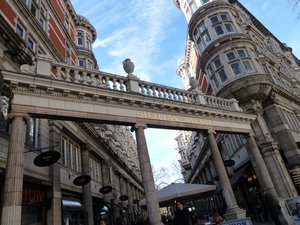Advertisement

 Sicilian Avenue
Sicilian Avenue
Authentic shops were lined along Sicilian AvenueHaving taken on a day off, Mark agreed to go for walk around Bloomsbury Squares on 9
th March.
We started our walk from Holborn station. We crossed the main road, Kingsway and High Holborn at the traffic lights and walked north up Southampton Row. We found very impressive building on the left, that is, Sicilian Avenue and a shopping paved with Sicilian marble.
We then walked up to Vernon Place and crossed Bloomsbury Way, and found Bloomsbury Square. We strolled through this little park diagonally from south to north.
At the north edge of the park, it led us to Great Russell Street where we could see the entrance of the British Museum. We walked on Montague Street. Majority of semi-detached Georgian buildings are used for Bed & Breakfast hotels – we found the Russell Hotel where my parents and my cousin & her mother stayed a few years ago.
Montague Street led us to Russell Square, built around 1800, one of the largest of the London’s squares. There were various types of flowers, shrubs, conifers and trees grown and had a number of statues and garden ornaments. We
saw crocuses on the ground. There were various types of flower bed with ornamental hedges surrounded by Christmas roses and pansies etc. Having seen these flowers, we felt spring was coming on the way.
Next, we crossed road at the traffic lights, turned left and then right up to Bedford Way. We headed northwards while looking at the building of University of London.
We then found the green park, Tavistock Square. The east side showed a very distinctive building, BMA (British Medical Association) building. We were told that there used to be Tavistock House, where the novelist Charles Dickens lived, on the site of the BMA building. Tavistock Square had a number of copper beech trees a statue of the Indian pacifist Mahatma Gandhi. Colourful flowers were surrounding the wonderful statue. This little garden looked peaceful and seemed to be appreciated by university students. On the north end of the park, we found a cherry tree and a bind of paper cranes, and a large rock honouring the conscientious objectors – men who refused to fight during World War II.
Afterwards, we turned left, crossed the road and walked along Endsleigh
Place for Golden Square. Bloomsbury has been associated with artists and writers who were active in the early years of the 20
th century – Leonard and Virginia Woolf, Charles Dickens, Lytton Strachery (biographer), John Maynard Keynes (economist) – and we found those people’s statues, monuments and blue plaques in Bloomsbury. We found a wide variety of evergreen and deciduous trees in the park, and like Tavistock Square, Golden Square seemed to be an oasis for university students.
After leaving Golden Square, we walked through Woburn Square and along Thornhaugh Mews, and then found the back of British Museum on Montague Place.
We then reached Bedford Square. Bedford Square was surrounded by elegant Georgian building – used by while Coade stone – and built in an oval shape. Sadly, the park wasn’t open on 9
th March.
We walked to the southwest direction heading for Tottenham Court Road. As expected, bustling electronic shops and shoppers were around Tottenham Court Road, which made us feel that we finally came back to the real life of London, after walking through the tranquil gardens.
Advertisement
Tot: 0.211s; Tpl: 0.01s; cc: 14; qc: 58; dbt: 0.1381s; 1; m:domysql w:travelblog (10.17.0.13); sld: 1;
; mem: 1.2mb

 Sicilian Avenue
Sicilian Avenue